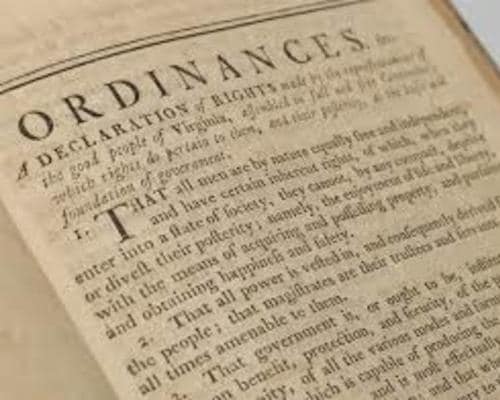
Virginia Declaration of Rights
As hostilities erupted between Great Britain and its thirteen colonies along the Atlantic coast of North America in the last quarter of the 18th century, the Second Continental Congress sent the “Olive Branch Petition” to King George III as a final attempt to avoid all-out war. Rebuffed by the King’s refusal to read it and his declaration that the colonists were not only traitors but were formally declared to be in rebellion, Congress voted for independence from Britain on July 2, 1776 and approved the Declaration of Independence two days later.
Even before that historic vote, New Hampshire had declared its independence and enacted its own Constitution, followed by South Carolina’s adoption of a new Constitution in March, 1776. Within months, most other states followed their example, including Virginia which approved its new Constitution on June 29, 1776. Among its drafters were James Madison and George Mason and it was accompanied by a Declaration of Rights, authored principally by Mason nearly two weeks earlier.
Consisting of sixteen articles, the Virginia Declaration of Rights affirmed the inherent rights to life, liberty, property and the pursuit of happiness and safety and declared that government derives from the people who retain the right to abolish the government when the government “shall be found inadequate or contrary” to these principles. It supported separation of powers, frequent elections, term limits and asserted a list of prohibitions on government in order to protect speedy trials of impartial juries; freedom of religion and the press; due process; and other rights. It banned self-incrimination in criminal trials, cruel and unusual punishment and baseless searches and seizures.
The Virginia Declaration of Rights was the model for Thomas Jefferson’s draft of the Declaration of Independence as well as the Bill of Rights proposed by Congress in 1789 and ratified by the states in 1791. Its author and delegate to the Constitutional Convention, George Mason, was one of only three members of the Convention who refused to sign the Constitution, primarily because it did not include a Bill of Rights. Read the Virginia Declaration of Rights here.